Back To Nature Gardening - Plants & Herbs
Posted on
Our patchwork of gardens have the potential to support a wide range of birds, bees and other creatures, should we create and allow the right habitat for them. In doing our bit to help beleaguered wildlife, we’ll also be shaping ourselves a beautiful, natural space to hang out and recharge in!
I have always enjoyed my garden tremendously, wherever I’ve lived and whatever its size. Over recent years I’ve looked to plant specifically to attract nature, as opposed to choosing anything that looks pretty ‘in the moment’ from Squires.
In this blog I share with you my favourite plants; those varieties that I have generally found the most beautiful and easiest to grow. Look out for snippets from (actual) experts like Dan Pearson, Sarah Raven and my garden and nature enthusiastic parents, Vanessa and Peter Rowe :-)).
For those who want to ‘dig deeper’, you’ll find further references at the bottom.
Perennials
{Perennials are flowering plants that bloom every year; some for a few weeks, others for months, at a time. They will last for a minimum of two years up to as long as a decade.}
In other words, a brilliant group of diverse plants to suit all soils/aspects and the mainstay of almost every (certainly my) garden! There are plenty of pollinating perennials (those that attract moths, bees and butterflies).
The plants I have suggested vary in structure and habit, and will give you a long flowering season. Whether buying for a window box or garden, try to adhere to this kind of diversity as it helps to attract different insect and bird species throughout the year (as well as giving you colour and show all year round).
Nepeta (Cat Mint/ Catnip) - An easy-to-grow mid-sized plant with soft silvery grey leaves and small petal free purple blooms (bees love these multi-blooms on one stem, as they can easily browse from one tiny flower to another). I’ve grown two batches of these in the garden (2 x 3 plants) and they flower from May right through to the end of summer. Also a herb, you can use the leaves in tea for a relaxing blend. Pot-Friendly, particularly Nepeta ‘Blue Moon’.
{Similar alternatives: Perovskia (Blue Spire), Erysimum ‘Bowles Mauve’ (an RHS award winning, ubiquitous plant that is widely available), Salvia (pink variety also available, works well planted in a bed with Nepeta).}
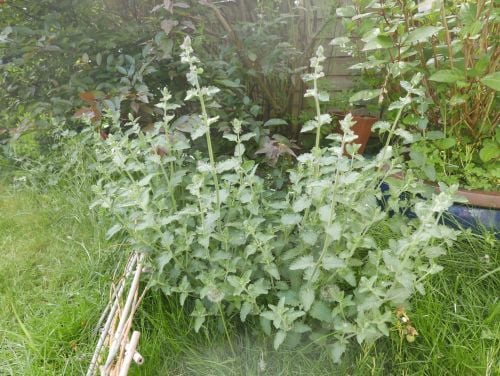 Nepeta on the brink of flowering, can't wait until it does!
Nepeta on the brink of flowering, can't wait until it does!
Lavender - Avoid the French ‘bunny-ear’ varieties. Bees prefer varieties like Lavandin x intermedia and Hidcote, as recommended by Dan Pearson. The older the lavender, the more bees will return year in and year out until your lavender is thrumming with them! Pot Friendly.
{Similar alternatives: Hyssop, Rosemary. I would definitely recommend a combination of all three as they will compliment each other and attract different bee species, plus provide you with an apothecary as all three are herbs!}
Erigeron karvinskianus (Mexican fleabane) - Gorgeous small daisy-like flowers, amassed atop green foliage from April to the end of summer. Such a crowd-pleaser! I grow this in a pot, but this clever plant sows itself into other nooks and crannies in paths and walls, and I have Brucie Bonuses popping up between my paving stones. Pot Extra Friendly.
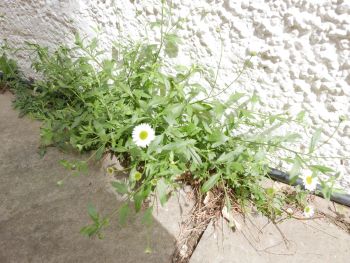 Pops up between my paving stones, just starting to come into flower.
Pops up between my paving stones, just starting to come into flower.
Sedum (Hylotelephium) - Sedums are a fabulous group of plants with a distinctive succulent-esque look that adds a sense of ‘brooding’ contrast to any border. They are easy to grow and drought tolerant. When other plants are past their best, sedums rise up with a mass of flowers in late summer and Autumn. Plenty to choose from, recommended varieties; 'Herbstfreude' and ‘Autumn Joy’. In Winter, ‘break the hollow stems and you will find little colonies of ladybirds sleeping in there. Best to find a rough corner for these…’ Dan Pearson.
{Similar alternative: Euphorbias - equally an all-round easy to grow, hardy plant with plenty of varieties to choose from. Mix and match with Sedum to good effect.}
Verbena Bonariensis - A distinctive tall plant beloved of the Cottage Garden (and my front garden). Its skinny stems are topped off with a myriad of small heads dotted with (even smaller) purple flowers. Butterflies love them, and birds feed from the dried seed heads in winter. The batch I planted (group of 3) shot up to 6 foot on no time, and are a joy to behold every time I approach the front door. Tuck in with other plants around for support - mine are nestled in between geranium 'rozanne’ (once voted plant of the century no less, and also beloved of bees) and lavender.
They continue to flower right through to late Autumn. Another self seeder, you can also dry the seed heads yourself and scatter them hither and thither.
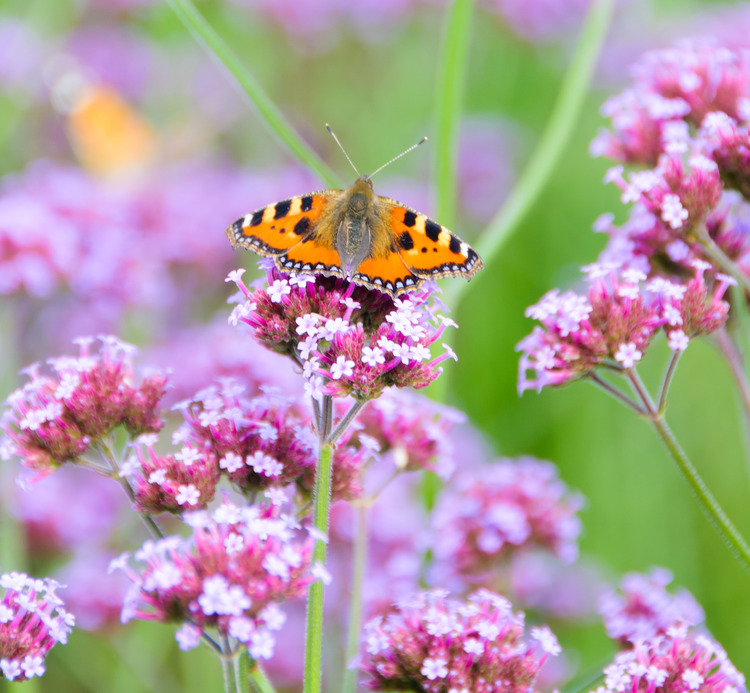 Photo from Rosy Bee, Plants For Bees. Verbena in Bloom.
Photo from Rosy Bee, Plants For Bees. Verbena in Bloom.
Eryngium Giganteum (Miss Willmott's ghost) - A tall spiky leafed plant with tiny pink flowers on a prickly cone. One of my favourite plants, they are a magnet for wildlife. I planted three of these, but my advice would be to plant at least five, as they take up very little space and would have more impact as a group.
Named after the nineteenth-century gardener, Ellen Wilmott, who liked to secretly scatter seeds 'hither and thither' in other people's gardens!
{Similar alternatives: Teasel (I’ve just planted 10 babies), Echinops (Globe Thistle)}
Common or Garden Honesty (Lunaria Rediviva) - Grown throughout my parent’s garden, this is one of the first plants to flower in Spring, and all the more welcome because of it. It’s also one of Sarah Raven’s favourites ‘It is easy to grow, will gently self-sow but not invade, and it thrives almost anywhere - in the sun or even in the shade of a hedge. It has a faint scent and gives a great splash of colour when there isn't much around.’
Honesty in my parent's garden
Other top perennials are: Early - Hellebores, Geranium, Pulmonaria, Mid - Echinacea, Lamb's-ears (Stachys byzantina), Late - Gaura.
Biennials/ Annuals
{Biennials are plants which have a two-year life cycle. In year one they grow roots, stems and leaves and in year two they flower, produce seeds and die. Annuals are plants that do all of this is one year}.
I don’t much go in for these types of plants, as they are generally less reliable and not as good for attracting pollinators. However, there are some native self-seeders (meaning they will pop up again) that are great for wildlife as listed below, and they are all good in pots.
Foxglove
Ox-eye Daisy (great for hoverflies rather than bees)
Hollyhocks (single flowered varieties only)
Lavatera ‘Barnsley’ (great for pots)
Forget-me-not
Sunflower
Cowslip
Sweet Pea
Scabious
As a general rule, it’s thumbs up for daisy-like blooms.Forget-Me-Not will re-seed and come back year in, year out.
Wildflowers
{Wildflowers may be perennial, biennial or annual}. Wildflowers by their very nature are wildlife friendly, particularly the native wildflowers, and there are hundreds to choose from!
For the average, non-meadow suburban garden owner, your best bet is to think ‘mini-meadow’ and dedicate a small area to wildflowers. The other option is to sow in sunny gaps in your flower bed (as I have done) or plant in pots.
I’ve have planted (10 of each) plugs of Wild Teasel, Self-Heal, Borage and Hemp Agrimony (from Landlife WIldflowers) as well as scattering some Beebombs in sunnier spots.
Check out How To Grow A Mini Wildflower Meadow for more advice.
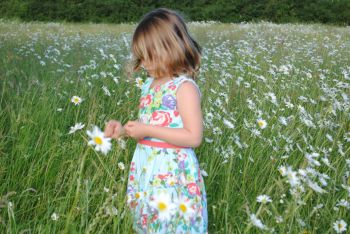
My daughter Rose seven years ago, in the early days of my parent's meadow (and when she still wore dresses!). You can see the beautiful Ox-Eye Daisies.
Herbs
Bee and insect friendly, plus you can use them in cooking. What’s not to love?! You don’t need to overwhelm yourself with planning out a ‘herb garden’. Pick your favorites and use in the beds or in pots.
Borage - Delicate, cucumber flavour with beautiful blue flowers. Leaves, flowers and stalks are edible, use over salads or to decorate cakes. Reputedly good for hangovers!
Fennel (Foeniculum vulgare) - ‘Few things are better for bees and hoverflies’, Dan Pearson. Pearson recommends ‘Giant Bronze’, it grows tall, up to 6 feet.
Wild Bergamont - A beautiful wild flower, leaves cab used to flavour meat or in herbal tea.
Marjoram
Thyme
Sage
Chives
Chamomile
I buy most of my herbs from www.rocketgardens.co.uk, who supply a wide range of grow your own fruit and vegetables. We have just purchased a Baby Salad Box for the front garden, which comes with the raised bed, compost and plants to make life easier!
No matter what the size of your garden, a combination of some or all of the above will give you a great bee-friendly space. Leave old stems and seed heads intact in Autumn and Winter, and they will help provide homes for small insects and food for birds. My next blog post will look at the best climbers, shrubs and trees for nature.
Where To Buy
http://www.rosybee.com/plants - a lovely, bijou selection of plants best for bees
https://www.sarahraven.com/flowers/plants/perennials_spring_summer_planting/+loved_by_pollinators_1 - an extensive shop with everything you might want or need for the garden! This is a list of plants loved by pollinators. All plants are sent without plastic.
https://www.bluebellcottage.co.uk/catalog/ - you need to know what you are looking for with this one, but the plants are very healthy and sent without plastic!
www.wildflower.co.uk - wildflower seeds and plugs, particularly good if growing over an extended area. Includes specific nature collections like ‘Bee Wildflower Plant Collection’ and ‘Wildflower Seeds For Moths’.
www.rocketgardens.co.uk - sells grow-your-own herbs, fruit and vegetables. Includes kits that are ready to go, like a Baby Salad Box that we are bought for the front garden, which comes with the raised bed, compost and plants.
Inspiration
Sarah Raven’s Pinterest Board ‘For The Bees’ - https://www.pinterest.co.uk/pin/369576713145338557/
Books: ‘Natural Selection’ by Dan Pearson and 'Wildlife Gardening For Everyone and Everything' by Kate Bradbury.
Please comment below with your own favourites, tips and tricks! All comments will be entered into a Prize Draw to win a bag of our an Eco Geek Starter Kit containing a bag of Beebombs, Natural Soap and Cotton Make Up Rounds Set of Three.
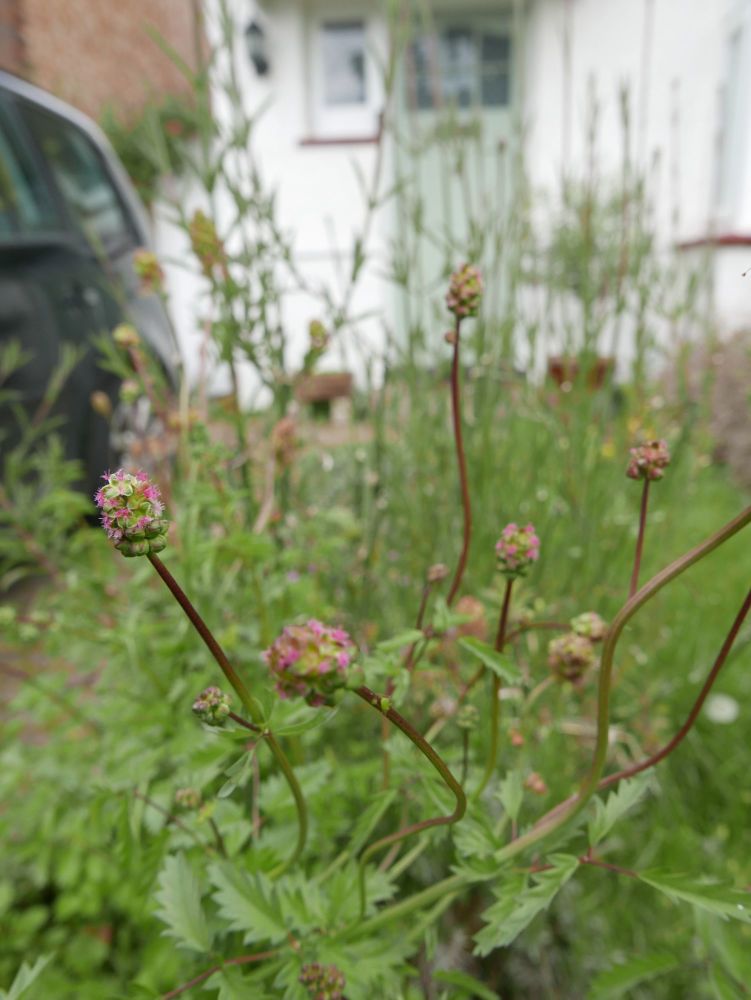
Salad Burnet next to Verbena and Geranium in my front garden. Hemp Agrimony planted in a pot next to the front door.
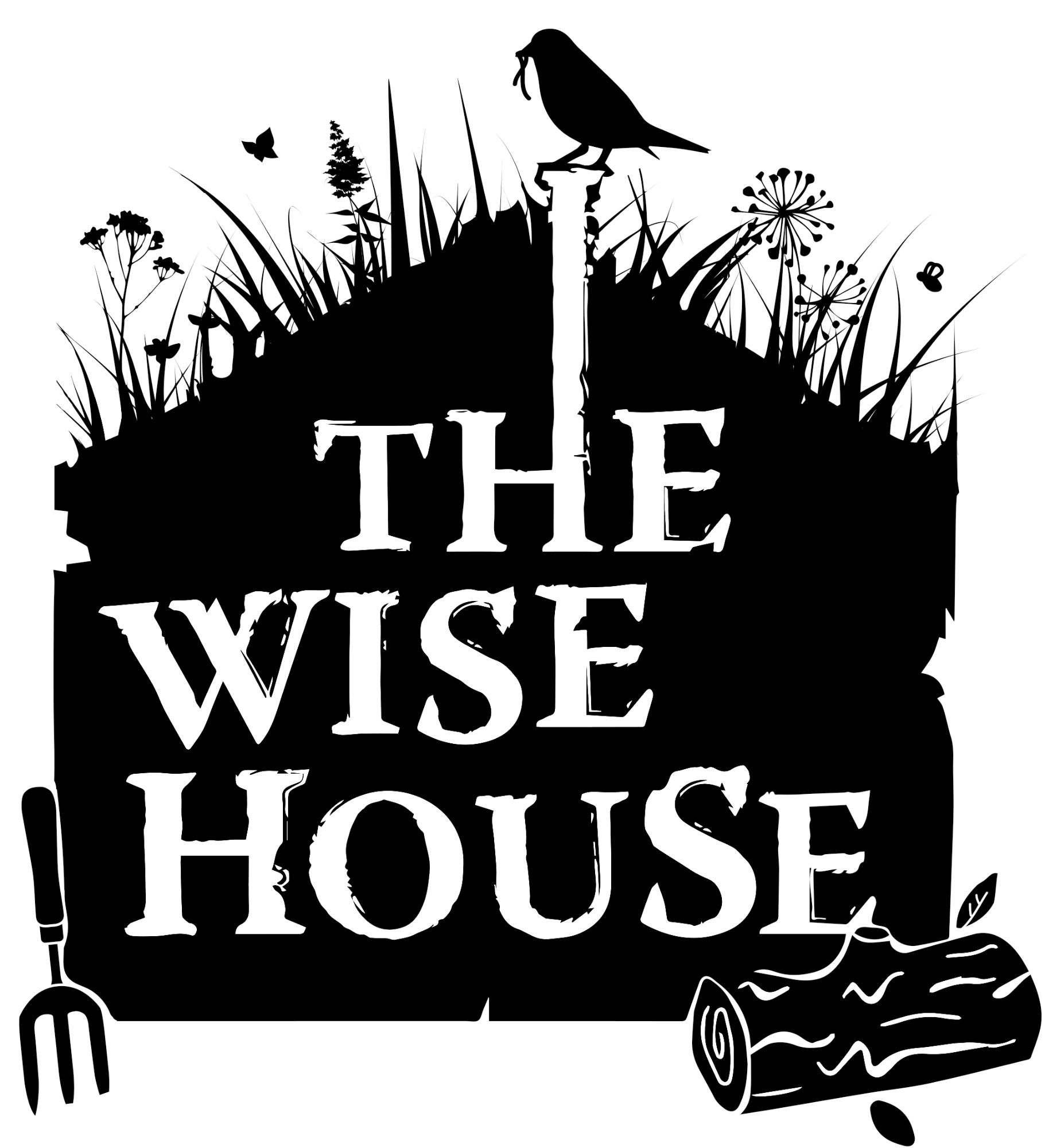
Add a comment: